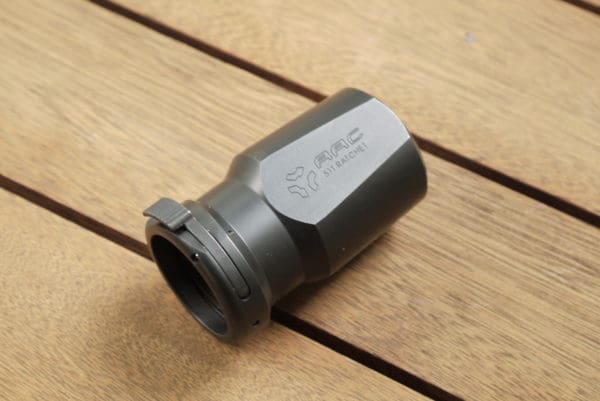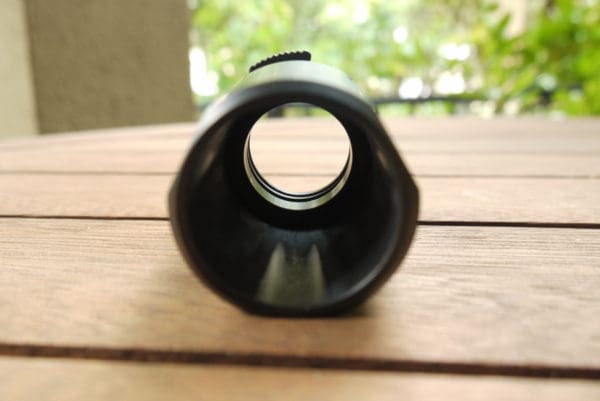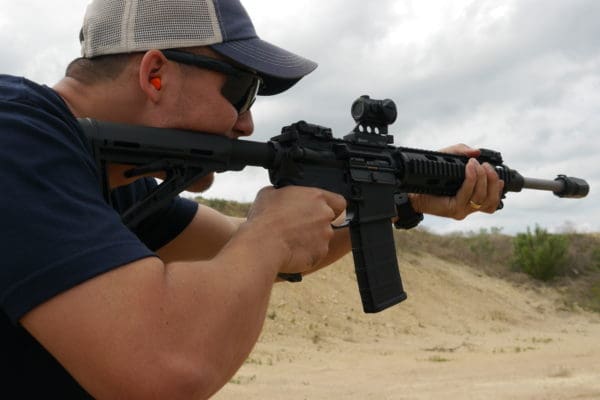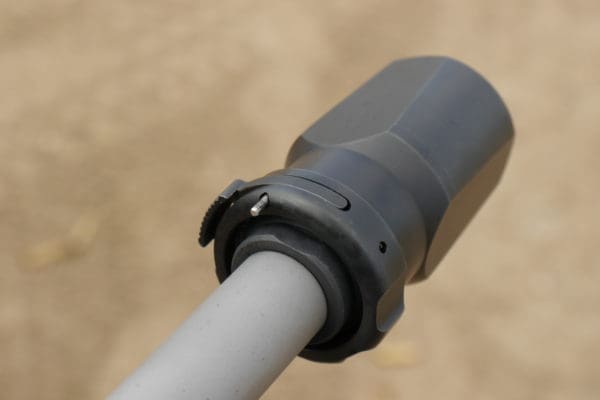So you’ve picked up a rifle like the DPMS Enhanced Tactical RECON that comes from the factory with a 51 tooth AAC silencer mount. Congratulations! Now what exactly do you do with that? For a lucky sliver of the gun-owning public, the obvious solution is to slap your AAC silencer on and have a good time.
But what if you don’t have a silencer? Or what if you want your gun to be as light as possible? And what if you also want to stop annoying everyone else on the range with your ridiculous muzzle brake? AAC has just the thing.
The ATF can be a bit particular when it comes to what you can and cannot thread onto the end of your rifle, but they have ruled time and again that things like “blast deflectors” are not silencers. They don’t reduce the report of a firearm in any meaningful way (and often increase the perceived noise downrange) so legally speaking they aren’t an NFA item. In short, you can buy them off the shelves without any additional paperwork.
AAC’s BlastOut is designed much like any of the other blast deflectors: simply. It threads onto the 51 tooth mount of your choice and provides a solid cylinder to “deflect” the muzzle blast of your gun forward instead of to the side. The front is completely open to allow the gasses to move otherwise unimpeded.
Interesting concept, but does it work?
In terms of reducing the report of your firearm? It’s about as useful as wishful thinking. The gun is still loud as all heck. Which is good — that’s exactly why the ATF says these things are A-OK. There’s no discernible impact on the performance of your chosen muzzle device: the muzzle brake will still do a great job reducing recoil, and flash hiders will still hide the flash.
Speaking of flash hiders, there’s one change that you will notice. AAC’s three prong flash hiders have a noticeable “PING” noise that they make whenever you fire a round or close the action. It acts like a giant tuning fork, and to me that’s incredibly annoying. Adding the BlastOut 100% eliminates that noise.
But that’s not why you’d buy it. The real benefit is when it comes to how your muzzle blast impacts the people around you.
You’re not going to notice the biggest benefit, but those standing to either side of you will. For those running the muzzle brake version of a 51 tooth adapter (especially those, like me, running it on a 10.5″ SBR) the noise and the gasses being thrown to either side from each successive shot are annoying enough to clear the benches on either side. In this respect the device works exactly as advertised, and will keep an intermittent fart of hot gasses from being blown into your neighbor’s face. It’s a neighborly thing to do.
One thing I’m a little disappointed about is the material. Take for example Dead Air Armament’s version: the Pyro. Their blast deflector is manufactured from the same metal as their silencers, making it easy to weld and work with. Theoretically, if some enterprising person wanted to make (and properly submit a Form 1 to register) a silencer in their own home they could use the Pyro as the attachment point and use Dead Air’s muzzle brakes on all their guns. AAC’s BlastOut is (as Mike Smith helpfully points out below) made from heat treated 17-4 stainless steel, but the odd shape makes for a difficult time attaching a suitable baffle stack.
I also had a small issue with the device. AAC’s ratchet system uses a pin to hold the ratchet in place. The latest designs allow this pin to be drifted out for replacement of the ratchet system should it wear out, a definite improvement that my 762-SDN-6 didn’t have. Out on the range the pin on the BlastOut wiggled loose and came about halfway out of the housing after only a couple hundred rounds downrange.
In theory it should stop there, since the ratchet was now out of alignment and placing additional friction on the pin to hold it in place. But I’d hate to be out on a dirt range when the pin finally walks all the way out and the first indication of a problem is when my new muzzle device goes flying downrange.
Here’s the $149 MSRP question: is it worth the money? Having spent a shockingly large percentage of my life on the firing line I know the annoyance of having someone else’s muzzle blast redirected into my face every couple minutes, and I would indeed appreciate it if more people were considerate of their neighbors by adding a silencer or blast shield like this to their gun. That said, the direct benefit to the shooter themselves is pretty minimal. I don’t think I’d pay $150 just to eliminate an annoying pinging noise.
Specifications: AAC BlastOut
Adapter: 51 Tooth
MSRP: $149
Ratings (out of five stars):
Overall: * * *
It works as advertised, and will definitely make for a more polite range trip. I’m just not sure that courtesy is worth the $149 price tag.









I like the silencerco version better. It lets you swap a flash hider for a surprisingly effective brake.
I have been hoping ya’ll would run a comparison with all the “blast sheilds” out there. I love my Noveske KX3/5.
Say you had two AR-15s, set up in exactly the same way, using exactly the same ammo, except one has a flash hider, and the other has the same flash hider PLUS one of these “blast deflectors”. If you were to fire them both in, say, a second-floor hallway (home defense style situation), would the rifle equipped with the blast deflector cause less hearing damage, since the blast is directed forwards?
Slightly off topic, but perhaps you’d know the answer:
I bought the DPMS Recon with the 51T Blackout flash hider. My suppressor is the older AAC 7.62-SDN with the 13T mount. The suppressor screws on just fine, but I assume there’s a high chance that it would back off without a 1:1 engagement of teeth. If I’m careful, do you see any big issues with firing a few rounds through it, without swapping out mounts?
Please contact AAC customer service and ask (770) 925-9988 or 1-844-700-0870.
IMO, there’s way too much money tied up in that can for you to be putting this to a vote on an internet forum.
Anything attached to the end of your barrel with the AAC 51 tooth QR will be loose. Not so it can come off, but there will be distinct wiggle room between the last two teeth you can get the ratchet to. Accuracy WILL be impaired. A properly locked up can will generally improve accuracy. A loose can is still a can, considerable benefits there if you don’t mind from appx. .5 to 1.0 bigger paper groups (YMMV). The accuracy degradation from the lighter blast deflector will not likely be as great as from a can, but the tradeoff doesn’t seem as “worth it.”
The 51 tooth system is just poor. My first can uses it, and I have 6 of the ($90 each!) muzzle devices. When I discovered the issue I called AAC and they recommend not trying to get it tight. “Tight” is only going to be slammed against the next tooth you can’t quite get over and after shooting the can will back off into the valley between teeth, where it can be wiggled with two fingers. The unavoidable change from tight to loose (when put on tight) worsens things. AAC’s “stay loose” advice is right. On the one 6.5 Grendel I shot it a lot with it seems that accuracy is not much affected that way, but it certainly isn’t improved.
I had occasion to discuss this with Bill Alexander (of Alexander Arms) and, while he readily agreed that the 51 tooth system is awful, he mentioned that when he silenced his Ulfbert (.338 Lapua self-loading) for unnamed special forces he used it, so I questioned that. He said that after delicate trial-and-error machining of the shoulder on the QD that the can tightens against so that when the can is screwed to a stop it is just barely over the last tooth it could clear, it will remain tight. I have had one muzzle device so machined and it works, and I’m trying to get the others machined, but it’s an oddball job hard to get done, and I have my doubts about this as a permanent fix, especially if I’m moving the can around on six guns.
” On the one 6.5 Grendel I shot it a lot with it seems that accuracy is not much affected that way, but it certainly isn’t improved.”
Why would you expect any suppressor to improve accuracy?
The 51T Blastouts are heat treated 17-4 stainless steel. Not aluminum.
Mike Smith/AAC
I zeroed with this on and should have checked poi but I didn’t. Do you have data on average poi shift for an m4 profile 16 inch barrel? Even just an estimate.
Comments are closed.